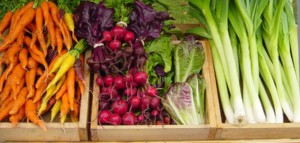This blog was written by Rachel Floyd, Vermont Foodbank VISTA/Americore 3SquaresVT Outreach Coordinator
I love farmers markets and I am on “food stamps.”
In fact, I love spending my SNAP dollars (food stamps) at the farmers market. Farmers markets are great places to 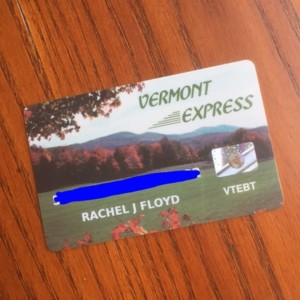 get food that hasn’t traveled far, is fresh and nutritionally dense, and supports the local economy. There are a ton of great reasons to shop at farmers markets, but for many low income folks, it can feel hard to participate in this part of the economy.
get food that hasn’t traveled far, is fresh and nutritionally dense, and supports the local economy. There are a ton of great reasons to shop at farmers markets, but for many low income folks, it can feel hard to participate in this part of the economy.
In the last few years, more and more farmers markets have started accepting SNAP dollars, which are loaded onto EBT cards, formerly called the food stamp program. And while this is crucial in the role of creating more access to high quality food, not many people on SNAP are utilizing this.
I get it.
Farmers markets are sometimes seen as a bougie, yuppie, upper crust place to stop on a Saturday morning. There is a specific set of barriers that low income folks face when it comes to thinking about utilizing the farmers market. Even if SNAP is accepted there, that’s not the end-all, be-all solution to healthy food access. There are a lot of reasons that a low income person might not go to the farmers market, some I’m aware of and some I’m not. My views are based on my experiences from growing up middle class in a farming community, living at/near the poverty line for 5+ years as an adult, and working in foodbanking for 3 years.
The following is a tutorial on how to use your SNAP/EBT/Food stamps at the farmer’s market considering some of those other barriers faced by other low income folks (some like myself, others with very different lives than me.) This blog is not comprehensive and does not address issues such as transportation or limited hours of some markets.
Decide to go. This is the hardest step to overcome (if you can find transportation to get there.) I’ve been to a lot of 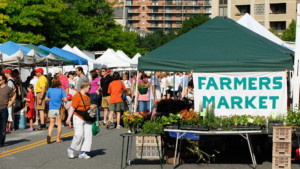 farmers markets in my life both as a kid and as an adult. It can still be intimidating. New places can be hard to visit, especially alone. Take a friend/partner/child if you feel comfortable. I like to take friends who have also used SNAP at some point because they understand the experience. In larger cities (and even in some small ones) farmers markets have entertainment and fun things to look at even if you don’t spend money. If it will make you feel more comfortable, try to commit yourself just to showing up. Farmers markets are public events in public spaces and everyone is welcome to look around and take up space.
farmers markets in my life both as a kid and as an adult. It can still be intimidating. New places can be hard to visit, especially alone. Take a friend/partner/child if you feel comfortable. I like to take friends who have also used SNAP at some point because they understand the experience. In larger cities (and even in some small ones) farmers markets have entertainment and fun things to look at even if you don’t spend money. If it will make you feel more comfortable, try to commit yourself just to showing up. Farmers markets are public events in public spaces and everyone is welcome to look around and take up space.
Find a market near you and make sure they accept SNAP. If you are interested in spending your SNAP dollars at the market, try to make sure that whatever market you go to actually does accept SNAP. I just google “my city” + “farmers market” + “SNAP”/”EBT”. Usually you can find their website or facebook page that may or may not have information. Sometimes if I can’t find information this way, I will email or privately message the farmers market and ask directly. “Can EBT be used at this market? If so, how can a person do that?”
Find the booth called “the market tent” or ask where you can 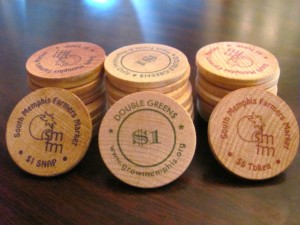 find the market manager. Once you have found a market that accepts SNAP, its time to find some delicious food! How do you do that? Most farmers markets work this way: You actually buy tokens from the market, then spend them at each individual stand.
find the market manager. Once you have found a market that accepts SNAP, its time to find some delicious food! How do you do that? Most farmers markets work this way: You actually buy tokens from the market, then spend them at each individual stand.
The tokens look something like this. These are examples from different farmers markets across the country so you have an idea of what they could look like at a market near you.
What I do: I look for the “market tent.” Sometimes these are well marked, sometimes they are not. I look for signs like these that mention SNAP or EBT. Here are some examples of what the signs could look like. Some farmers markets are better at having clear signs than others.
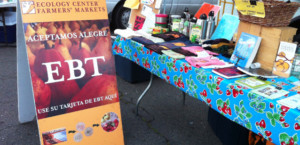 If you cannot find the market tent or a sign like this, don’t panic, especially if you know that the market does in fact accept SNAP. I look for the friendliest looking vendor (like the sweet old woman selling granola) and ask if she knows where the market manager is. Usually they can point you in the right direction to where you can cash in your SNAP and get some market tokens.
If you cannot find the market tent or a sign like this, don’t panic, especially if you know that the market does in fact accept SNAP. I look for the friendliest looking vendor (like the sweet old woman selling granola) and ask if she knows where the market manager is. Usually they can point you in the right direction to where you can cash in your SNAP and get some market tokens.
Decide how much you want to spend. Once you find the right person, they will ask how much of your SNAP you’d like to use. They will run your card through the machine, just like at the grocery store. You will type in your pin, just like at the grocery store. Money will be taken out of your account so that you can buy food, just like at the grocery store.
Get informed. The market manager can let you know how to use the program. If your market uses the above mentioned token system, each token is typically worth $1. Like a regular SNAP dollar, you can use it to buy fruits, veggies, nuts, meat, bread, cheese, and vegetable starts/seeds for your garden if you are so inclined. Unlike a regular dollar bill, you cannot get change back for your purchases. Try to round your purchases to the nearest dollar. Farmers at their stands are very helpful with this in my experience. Say I only bought $2.50 worth of tomatoes, they might throw in a generous handful of green beans to round it up to $3.
Another thing to keep in mind when using the tokens, be sure to find out if they can be used any other time or place. Some markets may happen twice a week, or in multiple locations in your city. Some markets are connected and use the same tokens, others use different tokens.
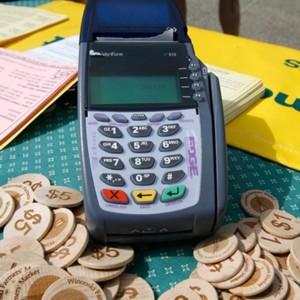 Last, some farmers markets have programs that lets you get extra market money for using your SNAP. In Vermont, there is something called Crop Cash, which allows me to effectively double my spending power. I tell the market manager that I want $10 taken from my EBT card and she gives me $10 in tokens PLUS $10 in Crop Cash. I now have $20 to spend. Farmers love this program because it puts even more money into the hands of you, the local vegetable loving consumer. Ask your market manager if they have this incentive program, which has different names in different places.
Last, some farmers markets have programs that lets you get extra market money for using your SNAP. In Vermont, there is something called Crop Cash, which allows me to effectively double my spending power. I tell the market manager that I want $10 taken from my EBT card and she gives me $10 in tokens PLUS $10 in Crop Cash. I now have $20 to spend. Farmers love this program because it puts even more money into the hands of you, the local vegetable loving consumer. Ask your market manager if they have this incentive program, which has different names in different places.
Spend your money at the market! You made it this far baby! Now get to shopping!
If your market uses the tokens, most vendors will accept them. Besides the change thing I explained in the above step, your tokens are basically cash. Buy whatever lovely food you want!
I tend to stick with produce that I know and love, and only occasionally will buy something new. I hate food waste, so I’m sometimes fearful to try something new in case I get it home and realize I don’t like it. I don’t have kids, but if I did, I would want to make sure they would eat whatever vegetable I purchased too.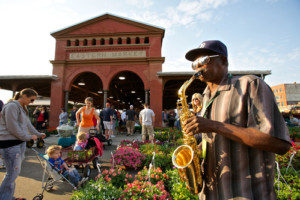
I love to look for vendors that offer samples of their products. This way I can taste it to see if I like it, but I can also talk to the vendor about how they like to cook it. Feeling brave enough to purchase beets but have no idea what to do with them once you get home? No better person to ask than the one who grew the beets in the first place! The farmer will likely be very happy to share their ideas with you. Sometimes they even have free recipe printouts they can give you.
Other things to remember:
It is your space too. Farmers markets are community events, and your community is made up of all kinds of people. Even in some of the richest parts of the country, there are still people struggling financially. Just because you are currently using SNAP to keep groceries on the table, doesn’t mean that you shouldn’t have the choice to buy good food at the farmers market.
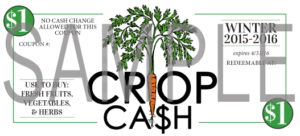 You don’t have to buy everything at the farmers market. I usually only spend about $10-$20 of my monthly SNAP benefit at the farmers market. I like the atmosphere, I like looking around at the nice displays and crafters, and I like whatever music is playing. It’s a social time in many communities and sometimes I just like walking around with friends even if I’m not buying anything that week.
You don’t have to buy everything at the farmers market. I usually only spend about $10-$20 of my monthly SNAP benefit at the farmers market. I like the atmosphere, I like looking around at the nice displays and crafters, and I like whatever music is playing. It’s a social time in many communities and sometimes I just like walking around with friends even if I’m not buying anything that week.
Many farmers themselves are also surviving on low incomes. Farming is a tough job and it is really hard to make a living doing it on a small scale. I have met a lot of farmers who wish they could make their produce less expensive, but often that would mean a pay cut from their already too small salaries.
You are bringing money into the local economy. Spending your SNAP at the farmers markets takes money from the federal government and puts it into your community. There is a body of research on something called “economic multipliers” that show that $1 spent at local farmers markets generates more than $1’s worth of economic activity. More dollars circulating locally makes for a stronger local economy and a stronger local community.